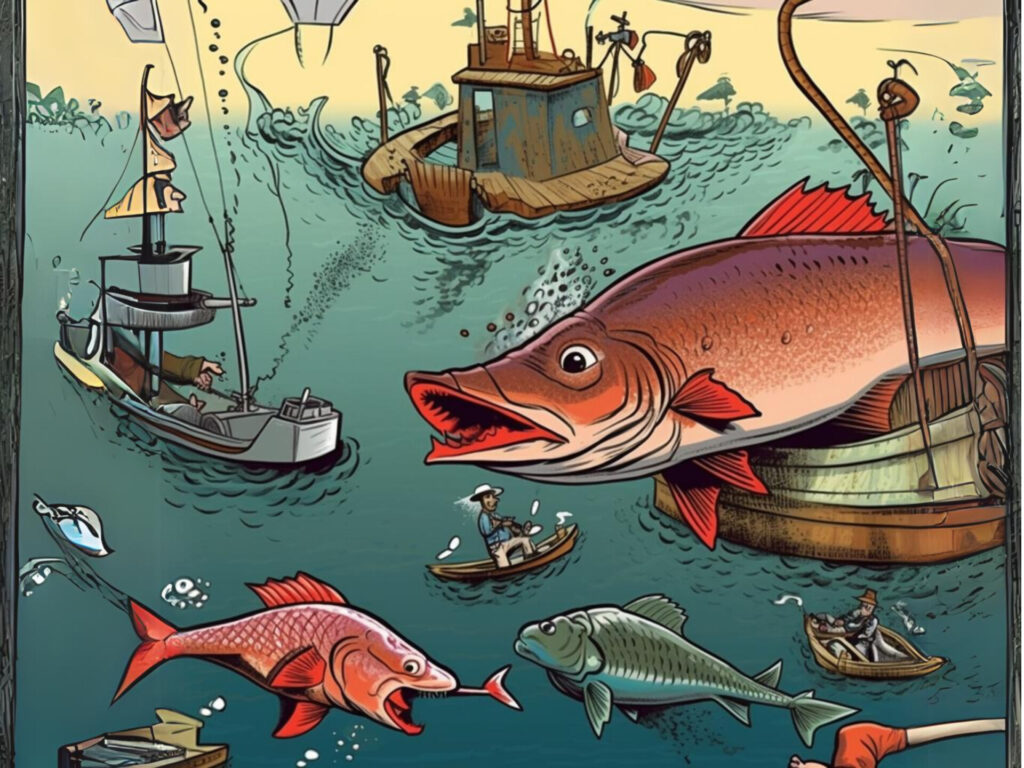If you’re an avid angler, you probably know that Tampa Bay is one of the most popular fishing destinations in the U.S. But with so many different types of fish in the area, it can be challenging to know where to start. In this article, we’ll discuss the different species you can catch in Tampa Bay and provide tips and techniques for catching some of the more popular fish, including redfish, snook, trout, and grouper. So keep reading to learn more about how to have successful and enjoyable fishing trips to Tampa Bay.
Types of Fish Found in Tampa Bay
Tampa Bay offers a wide variety of fish for anglers of all skill levels. From inshore species like snook and redfish to offshore game fish like grouper and tarpon, there’s no shortage of options.
Here are some of the most common types of fish you might expect to see in Tampa Bay:
-
- Redfish – Also known as red drum, these fish are a staple of inshore fishing in Tampa Bay. Redfish can be caught year-round, but are most abundant in the early fall.
-
- Snook – Another popular inshore species, snook are known for their long, slender bodies and huge mouths. They’re active year-round in Tampa Bay, but can often be found in deeper waters during cooler months.
-
- Grouper – These big game fish are a common target for offshore anglers in Tampa Bay. Grouper can be caught year-round, but are most plentiful during the summer months.
-
- Tarpon – Known for their incredible strength and acrobatic jumps, tarpon are often considered the ultimate game fish. They can be found in Tampa Bay from May through August.
-
- Trout – Depending on the time of year, trout can be found both inshore and offshore in Tampa Bay. They’re a popular target for beginners because they’re relatively easy to catch.
-
- Sheepshead – These fish have a distinctive striped pattern and are known for their sharp teeth, which help them feed on crustaceans. Sheepshead are abundant year-round in Tampa Bay.
-
- Mangrove Snapper – A smaller species than some of the others on this list, mangrove snapper are still a favorite of inshore anglers. They can be found in Tampa Bay year-round.
-
- Spanish Mackerel – These speedy fish are a common target for both inshore and offshore anglers in Tampa Bay. They’re most abundant in the spring and early summer.
Remember, fishing regulations in Tampa Bay vary depending on the species and time of year, so be sure to do your research before you hit the water. And always make sure you have the necessary fishing license and equipment.
The Best Time to Fish in Tampa Bay for Different Species
If you’re looking for a successful fishing trip in Tampa Bay, timing is everything. The majority of fish species found in the bay have specific spawning and feeding seasons that can affect your chance of a catch. Knowing when and where to fish can make all the difference.
Redfish and snook are two of the most sought after species in Tampa Bay, and the best time to catch them is during the fall months. Redfish tend to school up and move inshore during this time, providing easier access for fishermen. Snook, on the other hand, tend to move towards the backwaters and tidal creeks to feed on baitfish. Early mornings and late afternoons are the best times to fish for both species.
For offshore fishing, the warmer months from May to September tend to be the prime time for grouper and other big game fish like tuna and mahi-mahi. Grouper tend to congregate in deeper waters during their spawning season in the summer months, providing an opportunity for offshore fishermen to reel them in. Trolling with lures or using live baits like pinfish or squid can produce the most success.
Trout and snapper are abundant in Tampa Bay year-round, but the best time to catch them varies slightly. For trout, the cooler months from October to March tend to provide the best bite. They tend to school up in deeper water and near structures like oyster bars and grass flats. Live shrimp or artificial lures like MirrOlures can work well for catching these species. For snapper, the summer months tend to be the most productive. They tend to gather around structures like rock piles and artificial reefs, providing a great opportunity for inshore fishermen to reel them in.
Overall, understanding the seasonal patterns of different species in Tampa Bay is crucial for a successful fishing trip. Keep in mind that fishing regulations and license requirements may vary depending on the time of year and species you’re targeting. Be sure to check with local authorities and obtain the necessary permits before heading out on your fishing adventure in Tampa Bay.
Fishing Techniques to Catch Redfish and Snook in Tampa Bay
If you’re looking to catch some redfish and snook in Tampa Bay, it’s important to know the best fishing techniques to increase your chances of success. Here are some tips and tricks to keep in mind:
-
- Use the Right Bait: When it comes to catching redfish and snook in Tampa Bay, live bait such as shrimp, pinfish, and sardines tend to work best. You can also try using artificial lures like soft plastics or topwater lures.
-
- Know When to Fish: Redfish and snook are often more active during early morning or late evening hours, so plan your fishing trip accordingly. Additionally, pay attention to the time of year as different seasons can affect the feeding patterns of these fish.
-
- Target the Right Areas: Look for spots where redfish and snook tend to congregate, such as mangrove shorelines, oyster bars, and grass flats. By fishing in these areas, you’ll have a better chance of hooking these elusive fish.
-
- Patience is Key: Redfish and snook can be finicky, so be patient and persistent. Try different techniques and experiment with different baits until you find what works best.
-
- Be Mindful of Regulations: Make sure you’re following all fishing regulations in Tampa Bay, including size limits and bag limits for redfish and snook. It’s also important to practice catch and release to help preserve these fish populations for future generations.
By following these fishing techniques, you’ll be well on your way to catching redfish and snook in Tampa Bay. Keep in mind that fishing can be unpredictable, so don’t get discouraged if you don’t catch anything right away. With some practice and perseverance, you’ll become a skilled angler in no time.
Offshore Fishing for Grouper and Other Big Game Fish in Tampa Bay
If you’re looking for a thrilling adventure in Tampa Bay, consider offshore fishing for big game fish like grouper and snapper. Here’s what you need to know before you head out on the water.
Offshore fishing in Tampa Bay usually involves traveling farther out from shore, where the water is deeper and the fish are bigger. You may need to hire a fishing charter to take you to the best offshore fishing spots, which can include wrecks, artificial reefs, and natural ledges.
When it comes to catching grouper and other big game fish, the bait you use can make all the difference. Consider using live bait like pinfish, grunts, and pilchards or cut bait like squid or mullet. Some fishermen also prefer to use jigging lures or trolling plugs to entice the fish.
Make sure to bring the right equipment for offshore fishing. You’ll need a sturdy rod and reel, heavy line (at least 30-pound test), and a fishing gaff to help you land the big catch. You may also want to consider using a fish finder to locate the best spots for grouper and snapper.
Once you hook a grouper or other big game fish, be prepared for a tough fight. These fish are strong and will try to swim back to their hiding spots in the wreckage. Keep your line tight and use a slow, steady motion to reel in the fish. And don’t forget to wear gloves to protect your hands when handling the fish and gaff.
Before you head out on your offshore fishing adventure, make sure to check the regulations and limits for fishing in Tampa Bay. Some fish like grouper have size limits and bag limits, so it’s important to know what you can and cannot keep.
Offshore fishing for grouper and other big game fish can be an exciting and rewarding experience in Tampa Bay. With the right equipment, bait, and technique, you can land a trophy catch that you’ll never forget.
Recent Posts
Inshore Fishing: Tips and Tricks for Catching Trout and Snapper in Tampa Bay
Inshore fishing in Tampa Bay is a great option for those looking to catch some smaller game fish like trout and snapper. Here are some tips and tricks to help you make the most out of your inshore fishing experience.
-
- Know the Tides: Understanding the tides and how they affect the movement of the fish is a key factor in successful inshore fishing. Find out when high tide and low tide occur, and plan your fishing trip around those times.
-
- Use Live Bait: Live bait is always a great option for catching trout and snapper. Shrimp and small baitfish work well in Tampa Bay. Make sure to rig your bait properly and keep it as lively as possible to attract the fish.
-
- Switch Up Your Lures: If live bait isn’t your thing, switching up your lure can sometimes make all the difference. Soft plastics and small jigs tend to work well in Tampa Bay for trout and snapper. Experiment with different colors and shapes to see what the fish are biting on that day.
-
- Look for Structure: Trout and snapper tend to hang around structures like docks, bridges, and oyster beds in Tampa Bay. Keep an eye out for these structures and fish around them for the best results.
-
- Stay Stealthy: When fishing for smaller game fish like trout and snapper, it’s important to stay quiet and stealthy. Avoid making loud noises or sudden movements that could spook the fish.
By following these tips and tricks, you’ll be well on your way to catching some trout and snapper during your inshore fishing trip in Tampa Bay. And always remember to follow fishing regulations and practice sustainable fishing practices for the health of the ecosystem.
The Dos and Don’ts of Catch and Release Fishing in Tampa Bay
If you’re an ethical angler looking to catch and release fish in Tampa Bay, it’s important to understand the dos and don’ts to ensure the fish you release survive to swim another day.
Do:
-
- Use barbless hooks: Barbless hooks cause less damage to the fish’s mouth and make it easier for you to remove the hook without injuring the fish.
- Use circle hooks: Circle hooks are designed to hook the fish in the corner of the mouth, which reduces injury and increases the chances that the fish will survive.
- Keep the fish wet: Keep the fish wet at all times to prevent it from dehydrating. If you take the fish out of the water for a photo, be quick and make sure to keep it in the shade.
- Use proper equipment: Use light tackle and equipment that is suitable for the size of fish you’re targeting to reduce the chances of injuring the fish.
- Revive the fish: Hold the fish in the water and move it back and forth to get water over its gills. Once the fish is revived and can swim on its own, release it.
- Use barbless hooks: Barbless hooks cause less damage to the fish’s mouth and make it easier for you to remove the hook without injuring the fish.
Don’t:
-
- Use lip grippers: Avoid using lip grippers to handle the fish as it can damage their sensitive mouth tissue and dislocate their jaw.
- Keep the fish out of water for too long: The longer you keep the fish out of the water, the more stressed it becomes, which can reduce its chances of survival.
- Take the fish out of the water for a photo: Try to take a quick picture while the fish is in the water, or hold it out of the water for a few seconds at most.
- Hold the fish by the gills or eyes: Never hold a fish by its gills or eyes as it can cause irreversible damage.
- Release the fish in shallow water: Make sure to release the fish in deep water, away from structures like rocks or bridges, to prevent it from being an easy target for predators.
- Use lip grippers: Avoid using lip grippers to handle the fish as it can damage their sensitive mouth tissue and dislocate their jaw.
By following these dos and don’ts, you can ensure that the fish you catch and release have a better chance of survival, which is important for maintaining a healthy fish population in Tampa Bay.
As we conclude our guide, we’d love to hear from you!
Share your Tampa Bay fishing adventures in the comments.
Your stories and tips are invaluable to our community of anglers. Let’s keep the conversation going!



